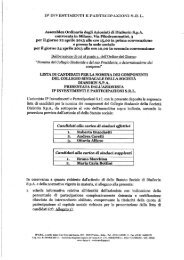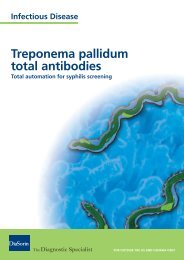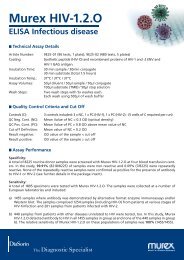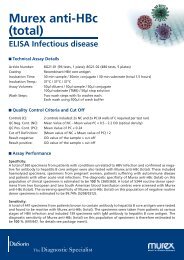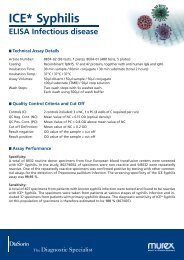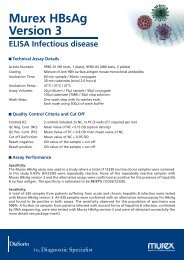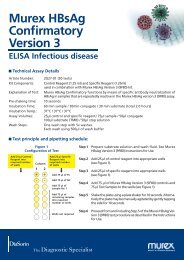Syphilis Booklet - DiaSorin
Syphilis Booklet - DiaSorin
Syphilis Booklet - DiaSorin
Create successful ePaper yourself
Turn your PDF publications into a flip-book with our unique Google optimized e-Paper software.
and specificity. Its use with modified FTA-ABS<br />
19S IgM should be preceded by serum<br />
fractioning, though this method does not<br />
improve sensitivity and the false-negative rate<br />
is 30 to 35%. Hence, only a positive result<br />
achieved with this test would confirm the<br />
diagnosis. The sensitivity of all IgM tests is very<br />
low in asymptomatic forms of congenital<br />
syphilis; so only positive results confirm<br />
diagnosis. The complexity required to carry<br />
out this test properly combined with its low<br />
sensitivity means it is useless. The same occurs<br />
with FTA-ABS 19S IgM for serum and FTA-ABS<br />
for 1/5 diluted CSF.<br />
3. Use of diagnostic tests.<br />
Clinical interpretation of results<br />
Four tests are available to diagnose any disease<br />
form: two direct, treponemes visualization test<br />
and PCR, where positive results confirm the<br />
diagnosis, and two indirect, treponemal and<br />
reaginic tests. Each has a different biological<br />
meaning. Western blot and LIA should also be<br />
considered as confirmatory tests. The<br />
importance, accuracy and immediacy of direct<br />
diagnostic tests are often forgotten in an<br />
ambulatory setting and diagnosis is only based<br />
on indirect tests. We must remember that<br />
finding T. pallidum or detecting one of its<br />
components, namely DNA, ensures correct<br />
diagnosis. In the event of impossible diagnosis,<br />
serology becomes a valuable tool, as it is unique<br />
for assessing treatment efficacy. There however<br />
is a widespread opinion that the use of<br />
serological tests is predetermined, in other<br />
words, that reaginic tests should be used to<br />
analyse a greater number of samples and<br />
treponemal tests should be used to confirm the<br />
positive results from other tests.<br />
This can be explained by technical difficulties in<br />
performing routine immunofluorescence (FTA)<br />
tests in patients with suspected infections. Their<br />
use can no longer be justified merely as<br />
confirmatory tests today, with the development<br />
of new automated treponemal tests, simpler<br />
technical methods and improved sensitivity and<br />
specificity. Though this is still common practice,<br />
treponemal tests, ELISA and chemiluminescence<br />
particularly, should be included in first-line<br />
serological diagnosis 38,39 rather than being used<br />
only for confirmation.<br />
With this introduction, two diagnostic<br />
algorithms for adults to be performed on serum<br />
are proposed below, bearing direct test results<br />
in mind (Cf. Figures 3 and 4).<br />
Table 12: Sensitivity and specificity of some serological tests for syphilis diagnosis *<br />
Technique<br />
Dark-field microscopy<br />
VDRL<br />
RPR<br />
Chromatography<br />
FTA-ABS<br />
FTA-ABS (Congenital S.**)<br />
TPHA<br />
ELISA IgG<br />
ELISA IgM<br />
ELISA IgM (Congenital S.**)<br />
Western blot<br />
W. blot IgM (Congenital S.**)<br />
Chemiluminescence<br />
PCR<br />
Primary<br />
76%<br />
78% (74-87)<br />
86% (77-99)<br />
92%<br />
84% (70-100)<br />
77%<br />
76% (69-90)<br />
98%<br />
93%<br />
90%<br />
99%<br />
83%<br />
99%<br />
95%<br />
Secondary<br />
76%<br />
100%<br />
100%<br />
96%<br />
100%<br />
/<br />
100%<br />
100%<br />
85%<br />
/<br />
100%<br />
/<br />
100%<br />
95%<br />
Latent<br />
/<br />
96% (88-100)<br />
98% (95-100)<br />
96%<br />
100%<br />
/<br />
97% (97-100)<br />
64%<br />
?<br />
/<br />
100%<br />
/<br />
100%<br />
95%<br />
Late<br />
/<br />
71%<br />
73%<br />
95%<br />
96%<br />
/<br />
94%<br />
96%<br />
?<br />
/<br />
99%<br />
/<br />
99%<br />
95%<br />
*Modified from references 1 and 2. The figures in parentheses indicate value ranges in different series.<br />
** Symptomatic congenital<br />
Specificity<br />
Not syphilis<br />
/<br />
98% (96-99)<br />
98% (36-99)<br />
95%<br />
97% (94-100)<br />
/<br />
99% (98-100)<br />
98% (70-99)<br />
99%<br />
/<br />
100%<br />
/<br />
99%<br />
> 99%<br />
17



